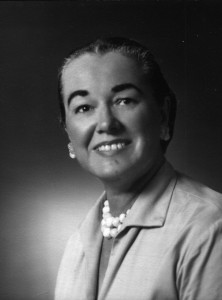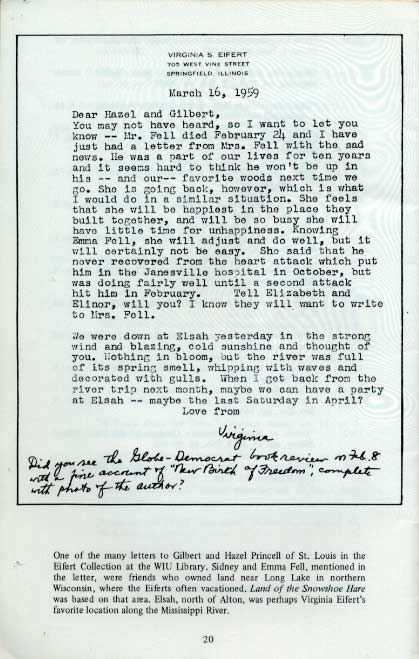Who Was Virginia?
October 11, 2015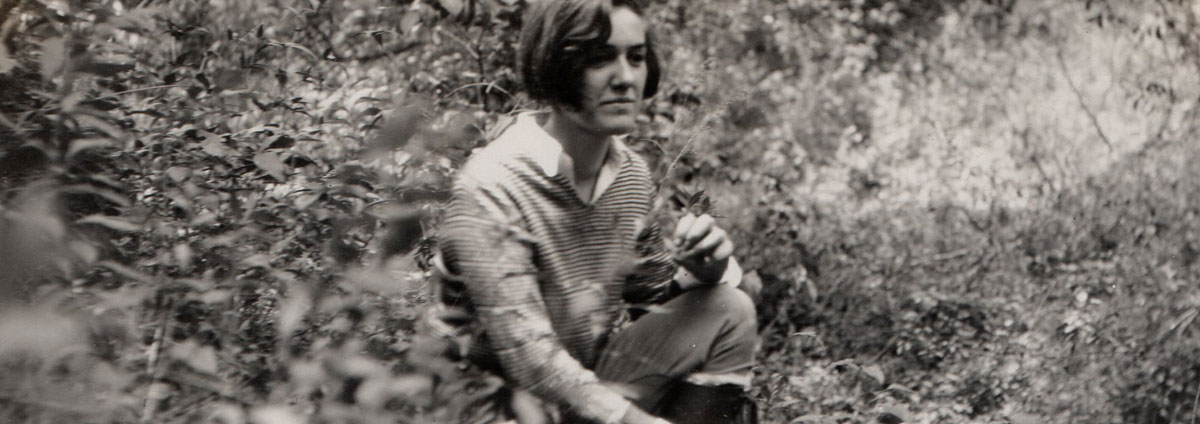
by Orvetta M. Robinson – former Illinois State Museum librarian.
With an introductory essay by John E. Hallwas – Western Illinois University, retired.
Published in conjunction with the Virginia S. Eifert Exhibit at Western Illinois University Library September – November 1981, Published jointly by Western Illinois University Library and the Illinois State Museum. Copyright 1981 by Western Illinois University Macomb, Illinois.
The illustration and others in this booklet are from the Virginia S. Eifert Collection at Western Illinois University Library and is used by permission.
The Legacy of Virginia S. Eifert A Bibliography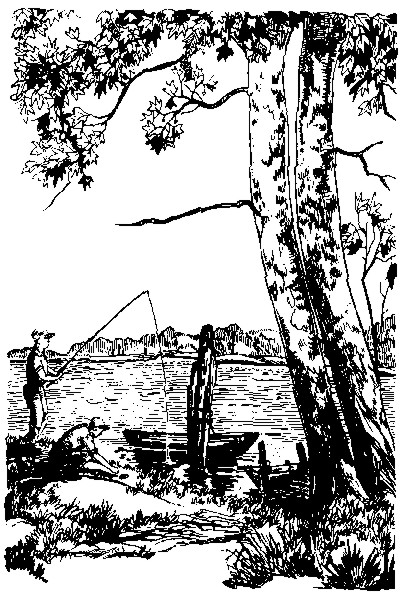
Introduction
by John E. Hallwas – Western Illinois University, retired.
Virginia S. Eifert, the noted naturalist, author, and artist of Springfield, Illinois, was born on January 23, 1911. In a life that lasted only fifty-five years she produced eighteen volumes of nature writing, cultural history, and biography, along with hundreds of articles on natural history subjects. Long before she died, she had become the most popular and articulate writer on the natural world of Illinois in the state’s history, as well as one of the more well-known nature writers in America.
During the past few years, Western Illinois University Library has assembled an extensive collection of her books, booklets, articles, letters, photographs, and art works in an effort to provide the public with convenient and perpetual access to her legacy. The Virginia S. Eifert Collection has been assembled through the donation of materials by her many friends and admirers. To browse among the literary and artistic works that Mrs. Eifert produced is to develop a greater sensitivity to the natural world, for her main purpose as an author and illustrator was to promote that kind of development.
Some of her finest writing appeared in The Living Museum, the Illinois State Museum publication that she initiated in 1939 and edited until her death in 1966. Month after month, she turned out nature essays of high quality, such as “Day in March” (1963), which concludes with a vivid description of the Illinois countryside at sunset:
“Now at sundown flocks of redwings and grackles stream over in the glow. A robin in the top of a maple sings a brief song. And in the long twilight, while an orange sky lingers behind black trees, the wet black fields with pools of melt-water reflect the dregs of light. Over an orange pool flies a stubby, long-billed bird which whirls upward with a whickering of wings, up, up, against the glow—the woodcock, calling nasally, spirals in its spring evening flight. Horned larks in small groups fly low over the muddy fields to grass clumps for the night, and in the transcendent light of dusk the great glowing body of Venus, the evening planet, is huge and low and bright.”
For Mrs. Eifert, to deeply experience the natural world, by being aware of the various activities and processes going on at a particular place and time, was to live in “the thrilling present” of nature, a realm of “unending mental and physical adventure.” Her vibrant nature writing has encouraged many people to seek that kind of experience.
Virg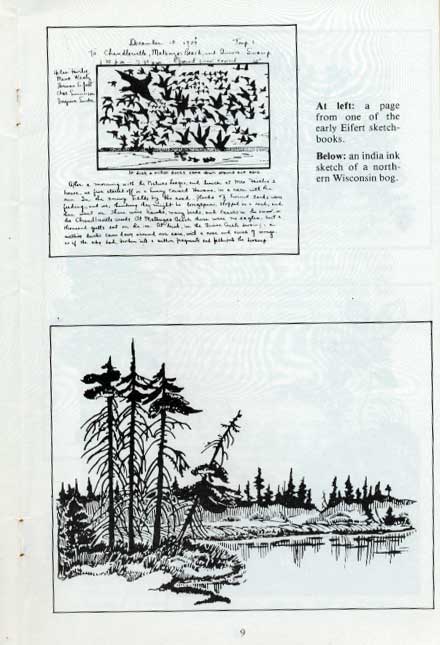 inia Eifert was convinced that sensitivity to nature could be, and should be, taught and that our sense perception could undergo dramatic improvement. Of man’s too-often-neglected auditory ability, for example, she once wrote,
inia Eifert was convinced that sensitivity to nature could be, and should be, taught and that our sense perception could undergo dramatic improvement. Of man’s too-often-neglected auditory ability, for example, she once wrote,
“The sense of hearing is something to be cultivated. It must first spring from a willingness to be aware, of not letting all the sounds out of doors become a blur which merges with the general, rushing undercurrent of the sounds of civilization. To listen—really to listen —is to hear the difference in the night songs of snowy tree crickets and black crickets, in orchard orioles and Baltimore orioles; it is to take note of small sounds of birds flying over on a spring or an autumn night, to hear the pulsations of a bat’s wings swooping past, to distinguish trees by the rustle of their leaves.”
Mrs. Eifert herself exhibited a very heightened perceptual sensitivity, to the frequent amazement of those whom she took on nature walks in the Springfield area and at The Clearing in Door County, Wisconsin.
Moreover, she urged people to become aware of “the powerful, complicated simplicity of nature,” its deep and pervasive symmetry, its repetition of design. In an essay called “The Wave” (1962), for example, she made the following comments:
“The wave breaks on the shore, disperses, draws back, forms, crests, comes forward white-combed, and breaks again as waves have been breaking on shores ever since there were waters and winds and shores, almost as long as the earth itself has existed. As the water draws back—sea-shore, lake-shore, pond-shore, mud-puddle in the path—the waves leave their mark in an undulating pattern. It is like an unwound spiral laid there. The same unwound spiral carves the dunes and rocks. The same wave pattern is plainly designed on many sea shells and in their contours, as if they were ornamented to fit their environment. The trees on the horizon present an undulating line against the sky. So do clouds, the wind over wheat, the course of a stream or river, the leap of a grasshopper, the grace of antelopes, the flight of bats—that same basic wave-form which archaic waters imprinted on beaches long since turned to stone.”
This kind of awareness of patterns and continuities led to the most well-known statement of her sense of relationship to nature, which appears at the end of River World: “I stand on the shore and know that it was here yesterday, and will be here tomorrow, and that, therefore, since I am a part of its pattern today, I also belong to all its yesterdays and will be part of all its tomorrows. This is a kind of earthly immortality, a kinship with rivers and hills and rocks, with all things and all creatures that have ever lived or have their being on earth. It is my assurance of an orderly continuity in the great design of the universe.”
She also recognized that contact with the natural world was very important to human well being—a notion that received its most famous expression a century earlier in Thoreau’s Walden. With regard to the natural world at night—a favorite subject for her-Mrs. Eifert once said, “The calm night does its work. It builds up an armor of serenity, so that, newly fortified, a man may face the harassing day; he has the placid sounds of whip-poor-wills and night-wind in his ears, the mystery of trees before him, and the stars above his head.”
And she frequently stressed that commonplace natural settings —a field, a pond, a backyard—could provide delightful and enriching experiences for any person who was willing to devote his or her attention to the outdoor world. As she put it, “To see the year is to adventure into deep truths laid freely open not only to philosopher and scientist but to any one of us on his way home from work, or out fishing, or gardening, or simply looking from a window, or laying a hand against a tree trunk, or examining with new vision the wonder in a snail, a stone, a star.” Of the more common natural settings, perhaps her favorite was the country road. In an essay by that title, written in 1955, she invites the reader to experience the November countryside:
“Walk along a little way, pause to watch the glint of sunlight on milkweed silk, listen to the voice of a red-tailed hawk flying over, and see how the sunlight shines through its wings; listen to the rattling of locust pods in the November wind, and discover the tracks of a raccoon in the muddy place near the creek. There is a special fragrance, too, in the November air which is neither that of blossoms nor of growing things, but of things past, a mingling of the scents of dead leaves lying damp on the ground, of earth that has been productive all summer and now lies moistly fragrant in the cornfield, a scent of sun-and-rain-drenched dust and the cool, portentous perfume of shadowed hollows where the breath of winter already seems to lurk.”
Mrs. Eifert had planned to publish a collection of her Living Museum essays but never did, and so after her death, the Illinois State Museum published more than 200 of them in a volume called Essays on Nature, edited by her husband, Herman Eifert, and her long-time friend and associate at the Museum, Orvetta M. Robinson. That collection, available only at the Museum shop, is still the finest single volume of nature writing by Virginia Eifert.
The commitment to appreciation of the natural world displayed in the essays led her to write three fine books of nature description: River World (1959), Land of the Snowshoe Hare (1960), and Journeys in Green Places (1963). These volumes brought her talents to a national audience. The first is based on her experiences aboard Mississippi River towboats, from Minnesota to New Orleans. The second is focused on northern Wisconsin, a frequent vacation area for the Eifert family, and the third is devoted to the natural world in Door County, Wisconsin, where The Clearing is located. (She taught adult-education classes in nature observation at The Clearing for a few weeks every year, from 1957 to 1966.)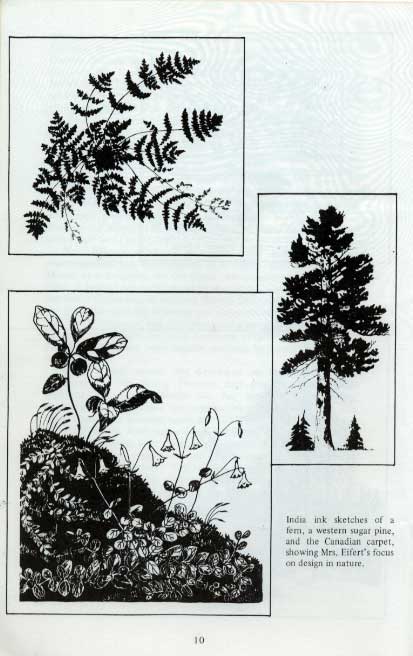
Her many other books are also associated in some way with the natural world. Two of the best are Men, Birds and Adventure (1962) and Tall Trees and Far Horizons (1965).The first re-creates exciting periods in the lives of men who discovered new species of birds—chiefly naturalists and artists like Mark Catesby, William Bartram, Alexander Wilson, and John James Audubon. The second chronicles the discoveries of pre-twentieth-century botanists in America, men and woman such as John Bartram, Jane Golden, Thomas Nuttall, and John Muir. Both volumes reveal the legacy of discovery that lies behind our appreciation of the natural world in America, and the combination of Mrs. Eifert’s vast knowledge of nature and her ability as a storyteller makes them delightful works of popular history in the field of nature study.
Even her biographies are associated with the natural world, especially the rivers of the Midwest. In her award-winning five-volume biography of Lincoln for young readers, she portrays the Railsplitter as sensitive to the Sangamon River at New Salem: “The river called with a most siren voice, and the smell and sight and sound of the river became part of his life.” That volume, Out of the Wilderness (1956), ends with the coming of spring and with young Abe yearning to travel south on the Sangamon, Illinois, and Mississippi rivers. Her other two biographies are Louis Jolliet, Explorer of Rivers (1961) and George Shannon, Young Explorer with Lewis and Clark (1963).
Mrs. Eifert’s work as a nature artist and photographer complemented her achievement as a writer. She had taken art lessons as a teenager, for her talent was already apparent at that time. A few of her early sketchbooks survive and are included in the Eifert Collection at Western Illinois University Library. Later, she provided india ink drawings and watercolors as illustrations for The Living Museum, and she completed a series of watercolors for her first book, Birds in Your Backyard (1941). She also did oil paintings, but those were usually retained by herself or given to friends.
Later in her career, she developed an interest in nature photography. The Living Museum and several of her books provided a constant outlet for her work. She also used photographs to illustrate her articles for nature magazines. The Eifert Collection includes hundreds of her photographs and slides, many of which have never been published. They also offer a stunning testament to her perceptual sensitivity and artistic talent.
Throughout her adult life, and in spite of a career that brought her increasing notoriety, Virginia Eifert was a very modest and private person, devoted to her husband, Herman, and her son, Larry. Fortunately, she was also devoted to communicating the intense experiences and personal satisfaction that she derived from the natural world. As a result, she left a literary legacy of lasting value to the American public. In the bibliography which follows, Orvetta Robinson provides a thorough and useful account of that legacy.
This list of writings by Virginia S. Eifert has been compiled as a resource for those who, having enjoyed her picturesque presentations in the past, may wish to search out the more obscure pieces and for those who, having been introduced to her writing in recent times, may wish to read more of her works.
Virginia Eifert began writing at an early age, as evidenced by collections of short essays, poems, diaries of fieldtrips, and other miscellanea preserved in notebooks and scrapbooks, many of them made as gifts for family and friends. Most are illustrated with pen-and-ink sketches, some enhanced with watercolors. Her poetry appeared in the local Springfield newspaper, the Illinois State Journal, as early as 1928, and in the early 1930’s she was writing a weekly nature column. From 1932 to 1935 she wrote, illustrated, and produced a mimeographed paper, Nature News, which she distributed to regular subscribers.
A student at Eastern Illinois State Teachers College in Charleston for the 1934-35 year, she was a member of Sigma Tau Delta and the Writers’ Club and on the staffs of The Warbler (Eastern’s yearbook) and the Teachers College News. During that school year, twenty of her articles were published in the News.
In 1939 she joined the staff of the Illinois State Museum to write and edit a new publication, The Living Museum, which she did until her death in 1966. During those years she also wrote articles publicizing the Museum and its services, provided for a time a newspaper column, “Know Your Museum,” and wrote five booklets in the Museum’s Story of Illinois Series and two in the Popular Science Series. She contributed articles about the Museum to the Quarterly of the Midwest Museums Conference and later served as editor of that publication.
In the 1940’s she began to submit articles to more periodicals, and during the 1950’s and 1960’s she wrote sixteen books for Dodd, Mead and Company. Other books were in process at the time of her death, some on paper and others still in her mind. Mrs. Eifert’s versatile knowledge and regard for her readers provided her with an endless variety of subjects, and she was constantly composing.
Virginia Eifert’s books were reviewed widely in both popular and professional publications. Among the newspapers were the Chicago Tribune, Christian Science Monitor, Illinois State Journal, Illinois State Register, New York Herald Tribune, New York Times, St. Louis Globe Democrat, and the San Francisco Chronicle. Other periodicals which published reviews include American Forests, Audubon Magazine, Booklist, Bookmark, Catholic Library World, Horn Book, Journal of the Illinois State Historical Society, Kirkus, Library Journal, Natural History, Nature Magazine, New Yorker, Saturday Review, and Wisconsin Library Journal.
Of the awards which Virginia Eifert received for her works, the most notable were those for Buffalo Trace. In 1955 that book won both the New York Herald Tribune Spring Book Festival Award and the Thomas A. Edison Foundation Mass Media Award. In December of that year it was dramatized on NEC radio on the “Carnival of Books” program, and in 1957 it was translated and published in Arabic in Damascus, Syria, by the United States Information Agency which operated the “Voice of America.” Out of the Wilderness received the Boys Club of America Junior Book Award in 1957. Some of her books were published for the visually handicapped as a result of the enthusiastic response over the years to the Braille edition of The Living Museum, the first and for many years the only natural history periodical available to this special group of readers. Seven titles were printed in Braille, and five were recorded as Talking Books.
Numerous articles about her activities and achievements have appeared in various newspapers in Illinois and in other states as well. Two extensive studies have been published: “The Achievement of Virginia S. Eifert,” by John E. Hallwas, in the Journal of the Illinois State Historical Society (Vol. 71, No. 2, May 1978, pp. 82-106) and “Virginia S. Eifert” in Unsung Heroines: A Salute to Springfield Women (1977) by Melinda Fish Kwedar, one of the Bicentennial Studies in Sangamon History published by the Sangamon County Historical Society.
Reprints of her work have not been included in this listing. Such entries would be repetitious. Furthermore, the search would be endless, for articles from The Living Museum have been reprinted nationwide in periodicals, newspapers, and newsletters, and they continue to appear. Segments from several of her books have been reprinted in periodicals, and the chapter, “The Rainy Day,” from Land of the Snowshoe Hare was selected for inclusion in Our Natural World (1965) edited by Hal Borland.
All of her books, except those published by the Illinois State Museum, are now out of print; however, copies are available in many libraries, as are the periodicals in which her articles appeared. Copies of all items listed here as well as copies of newspaper clippings and a list of known book reviews are in the Virginia S. Eifert Collection at Western Illinois University Library and at the Illinois State Museum. Other materials, such as unpublished manuscripts, drawings, paintings, photographs, slides, sketchbooks, and scrapbooks, are in the libraries of Western Illinois University, the Illinois State Museum, and Illinois State University.
Items in this bibliography are listed chronologically under Books, Booklets, Periodicals Edited, and Articles in Periodicals. Those written before September 1935 will be found under her maiden name, Virginia Cottet Snider.
